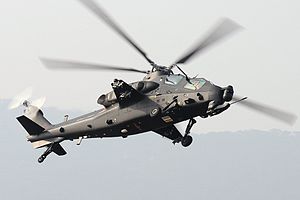CAIC WZ-10
| Z-10 | |
|---|---|
 |
|
| A Z-10 displaying at 2012 China International Aviation & Aerospace Exhibition. | |
| Role | Attack helicopter |
| Manufacturer | Changhe Aircraft Industries Corporation (CAIC) |
| Design group | Kamov |
| First flight | 29 April 2003 |
| Introduction | December 2012 |
| Status | In service |
| Primary user | People's Liberation Army |
| Number built | 100+ |
| Unit cost |
US$ 17 million
|
The CAIC Z-10 (Chinese: 直-10 for 直升机), also called WZ-10, is an attack helicopter developed by the People's Republic of China. It is designed primarily for anti-tank warfare missions but has secondary air-to-air capability as well. It was designed by Kamov design bureau of Russia under a contract with the Chinese government. It was further developed and flight tested by the 602nd Research Institute under Wu Ximing (吴希明) and is being built by Changhe Aircraft Industries Corporation (CAIC).
Nicknames of characters in the Chinese classic novel Water Margin have been used to name Z-10 and its smaller comrade Harbin Z-19: Z-10 is called Fierce Thunderbolt (Pi Li Huo, 霹雳火), the nickname of Qin Ming, while Z-19 is called Black Whirlwind (Hei Xuan Feng, 黑旋风), the nickname of Li Kui.
In September 2016, the PLA announced that all of its ground force aviation units had been equipped with the WZ-10.
In 1979, the Chinese military studied the problem of countering large armour formations. It concluded that the best conventional solution was to use attack helicopters. Eight Aérospatiale Gazelle armed with Euromissile HOT were procured for evaluation.
By the mid-1980s, the Chinese decided a dedicated attack helicopter was required. At the time, they used civilian helicopters converted for the military; these were no longer adequate in the attack role, and suitable only as scouts. Following this, China evaluated the Agusta A129 Mangusta, and in 1988 secured an agreement with the United States to purchase AH-1 Cobras and a license to produce BGM-71 TOW missiles; the latter was cancelled following the Tiananmen Square protests of 1989 and the resulting arms embargo. The colour revolutions prevented the purchase of attack helicopters from Eastern Europe in 1990 and 1991; Bulgaria and Russia rejected Chinese offers to purchase the Mil Mi-24.
...
Wikipedia
